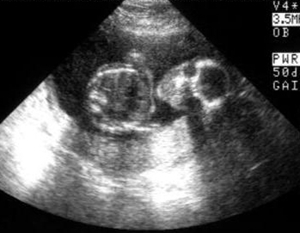
While you’re struggling to keep down breakfast in those first months of pregnancy, your little one is undergoing some remarkable changes. From a collection of cells, to a little being who can hiccup in your womb, here’s what’s cooking with your developing baby during the first trimester of pregnancy:
- Well before you may even know you’re pregnant, your future baby – just a zygote (or fertilized cell) has the genetic makeup he or she needs to determine gender, hair and eye color and much more. Amazing, right?
- The placenta and umbilical cord begin to form after the fertilized egg is implanted in your uterus. These will pass nutrients from you to your developing baby throughout the next nine months.
- Once the egg is implanted, we start to call it an embryo. Around the fifth week of pregnancy, incredible stuff is already happening: Your little one’s neural tube is beginning to form. One day, this will transform into his or her spinal cord. The makings of the nervous system – the heart, brain and blood vessels – are beginning to take shape, too.
- Around the sixth week, while you struggle to keep down breakfast, your embryo’s heart begins to pump blood. The neural tube closes and the beginnings of arms and legs begin to form as little buds for now.
- In these first weeks, your baby is well under an inch in size and has a shape like the letter C.
- By the time the seventh week rolls around, development is happening at breakneck speed. The brain and face are taking shape, and even tiny hands are beginning to form. Your baby’s nostrils may be developing and the head itself is the biggest portion of this tiny being.
- Next up? Welcome fingers and toes! For the time being, these miniature appendages are webbed and inter-connected, but that will all change soon enough. Around the time those develop, so too do the embryo’s lungs, nose, ears and eyes. The brain seems to turn itself on as brain activity begins.
- Around week eight, your developing embryo is measuring in at half an inch from crown to rump.
- At nine weeks, your embryo can officially hiccup! Though it will be some time before you can feel any of its movements. The heart is almost completely developed too.
- Once you hit 10 weeks, your little one will lose that webbing between its fingers and toes. Eyelids and nipples will form and, while you won’t feel a thing, your future baby will start wiggling around.
- By 10 weeks, your embryo has graduated to being called a fetus. With this name change, comes the formation of eyelids and genitals.
- For 11 weeks, your body has been hard at work growing this little human. At this point, nearly all of its organs are formed – and its genitals are taking on a male or female shape.
- Over the next two weeks, your little one’s face begins to fill out, arms and legs continue to grow and stretch, and your baby slowly uncurls itself inside the womb.
- Now that you have done all this hard work during your first trimester, your fetus can hiccup, stretch, extend a hand to its face and even sigh. Incredible, huh?


Leave a Reply